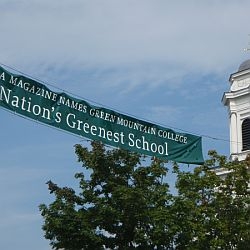 (Host) Car manufacturers are touting new electric models, snack food makers are coming out with biodegradable bags. . . even colleges and universities are touting their eco-friendly campuses and courses. Green Mountain College in Poultney is out front in this regard. Sierra magazine just named the liberal arts school the greenest college in the nation in its annual Coolest Schools issue. Nina Keck paid a visit recently to find out why.
(Host) Car manufacturers are touting new electric models, snack food makers are coming out with biodegradable bags. . . even colleges and universities are touting their eco-friendly campuses and courses. Green Mountain College in Poultney is out front in this regard. Sierra magazine just named the liberal arts school the greenest college in the nation in its annual Coolest Schools issue. Nina Keck paid a visit recently to find out why.
(Keck) A new biomass plant on campus may not attract students, but the eco-friendly power generator definitely scores points in the green category. Green Mountain College spokesperson Kevin Coburn says its one of many steps the school has taken to lessen its impact on the environment.
(Coburn) "Transportation is a big issue because many people have to commute to campus, faculty members and staff as well as some students. So this year we’re introducing zip cars to campus. One of which is a hybrid vehicle that students, faculty and staff can sign out and take day trips. So in many ways, we’re trying to cut down on our carbon footprint."
(sound of a cow mooing)
(Keck) That’s Astral, one of several cows who help teach the sustainable agriculture program. Well, teach may be overstating her role. but instructors at the college are using draft animals and other technologies to study ways to reduce the use of fossil fuels in agriculture.
(Sound of drilling and digging)
(Keck) For instance, two new high tunnel greenhouses are under construction on campus. Phillip Ackerman-Leist, heads Green Mountain College’s Farm and Food Program. He says instead of using gas powered heaters, which can be costly and pollute, these greenhouses will use solar powered water heaters.
(Ackerman-Leist) "The solar hot water actually runs through tubes under the soil a foot deep with one foot spacing between the tubes. So the idea is your actually heating the soil to promote root growth. And then as it comes through the soil the residual heat actually provides some of the ambient temperature in the greenhouse."
(Keck) Students are involved in every stage of the project from building the structures and planting the crops to gathering and processing data. Lucas Brown heads the college’s design and build program.
(Lucas Brown) "It’s one thing to sit in studio and develop drawings and designs of an ideal world. It’s another thing to go out to a farm, talk to a farmer about how they’re using the design, and then actually coming here and putting it together."
(Keck) Brown says students come to Green Mountain College because they want to make a difference and projects like this give them a chance to do it.
(Lucas Brown) "Where they know we’re using solar energy to heat the soil to grow food. It’s a real solution. It’s happening and they’re part of it."
(Keck) Green Mountain College established its environmental liberal arts mission in 1995. And while they may be pioneers, they are by no means alone in their efforts. Colleges and universities across the country have been working to green up their campuses. At Dartmouth College, trustees allocated $12.5 million for efficiency projects.
Middlebury college has invested in solar arrays, solar thermal heating and a demonstration wind turbine. These sorts of investments not only save energy, but are shrewed recruiting tools. According to a survey by the Princeton Review, two-thirds of college applicants say a school’s green record would influence their enrollment decision.
Back at Green Mountain College in Poultney, Phillip Ackerman-Leist says national recognition for their efforts is definitely good for the school. But he considers the Sierra magazine ranking a challenge to push for even more change.
For VPR news, I’m Nina Keck in Poultney.
(sound of a cow mooing)